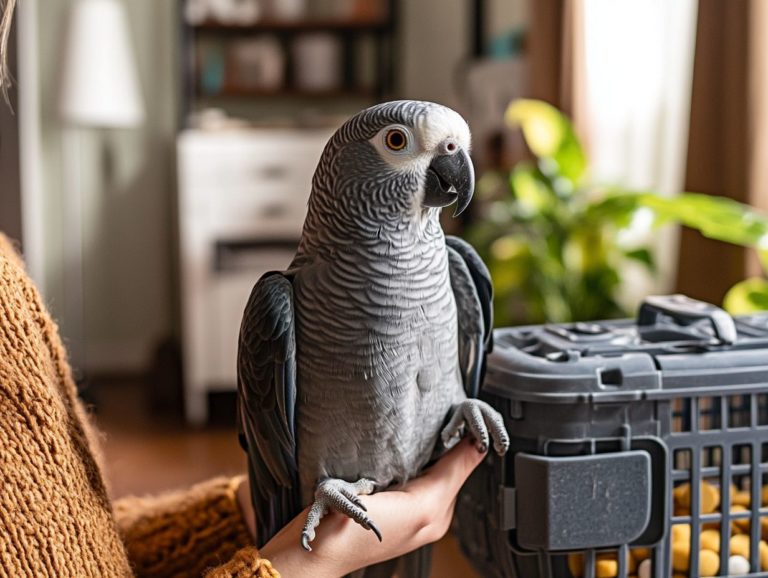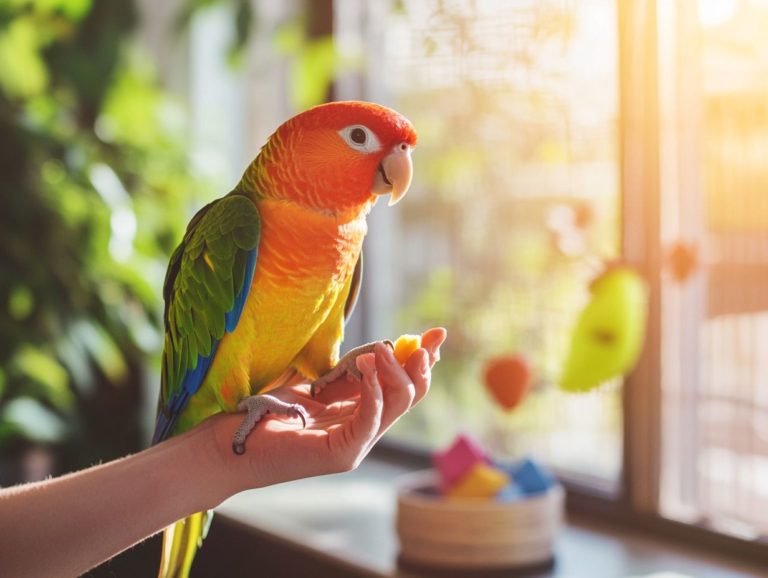Understanding Bird Flocking Behavior
Bird flocking behavior is a captivating phenomenon that reveals the intricate dynamics of avian life. It showcases various aspects of bird behavior.
From the mesmerizing formations that dance across the sky to nuanced social interactions within a group, flocking serves vital functions for survival and communication.
Get ready to discover the reasons behind why birds flock, the various patterns they create, and the ways they communicate while in the company of a group.
The article also explores the environmental factors that influence this behavior and discusses its implications for conservation efforts, flocking technology, and human flocking activities.
As you embark on this exploration, you ll unravel the complexities of how and why birds come together in flocks, illustrating the principles of collective motion and flock formation.
Contents
Key Takeaways:
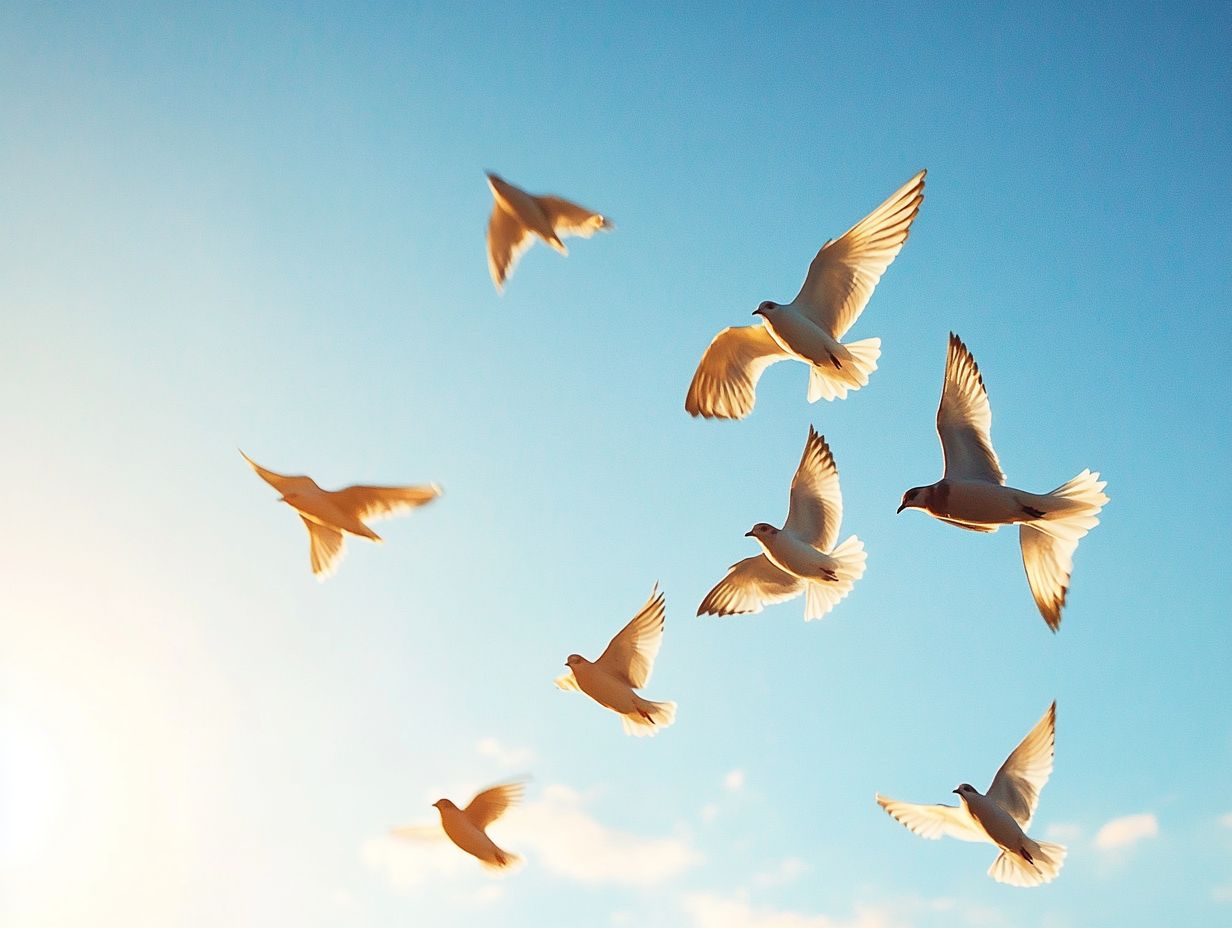
- Understand how flocking behavior enhances survival and social benefits, improving predator avoidance strategies.
- Learn how birds use various formations and movements to coordinate and communicate within flocks.
- Recognize the environmental and species-specific factors influencing flocking behavior and their implications for conservation efforts.
What is Flocking Behavior?
Flocking behavior is a captivating phenomenon you may observe in various species, particularly in groups of birds like the European starling. This collective motion is marked by intricate patterns that arise from simple local rules like separation, alignment, and cohesion.
These concepts were initially detailed by Craig Reynolds through his Boids model. The dynamics of flocking illustrate how individual actions combine to create group movements, resulting in a unified group movement that significantly enhances survival and social interaction.
Reasons for Flocking
Flocking plays a vital role in the animal kingdom, offering numerous survival and social advantages that boost the prospects of each group member.
Take birds, for example: their flocking behavior is a strategic response that enhances safety in numbers, making it harder for predators to target a single individual. Flocking also improves resource acquisition through communal roosting sleeping together in groups to stay safe and group foraging.
Survival and Social Benefits
The survival and social benefits of flocking are crucial, as many species find safety in numbers. This behavior aids in predator avoidance and resource sharing.
This phenomenon is captivating, illustrated by the mesmerizing murmurations of starlings. Imagine thousands of these birds moving in a synchronized dance, crafting intricate shapes that leave potential predators bewildered. By shifting positions rapidly and unpredictably, these birds cleverly reduce individual risk, showcasing a sophisticated strategy for evasion.
Flocking dynamics also enhance group cohesion during foraging and migration. When foraging together, individuals efficiently share information about food sources, maximizing resource acquisition. During migration, being part of a flock allows birds to conserve energy by riding the updrafts created by neighbors, significantly improving their chances of successful travel.
Types of Flocking Patterns
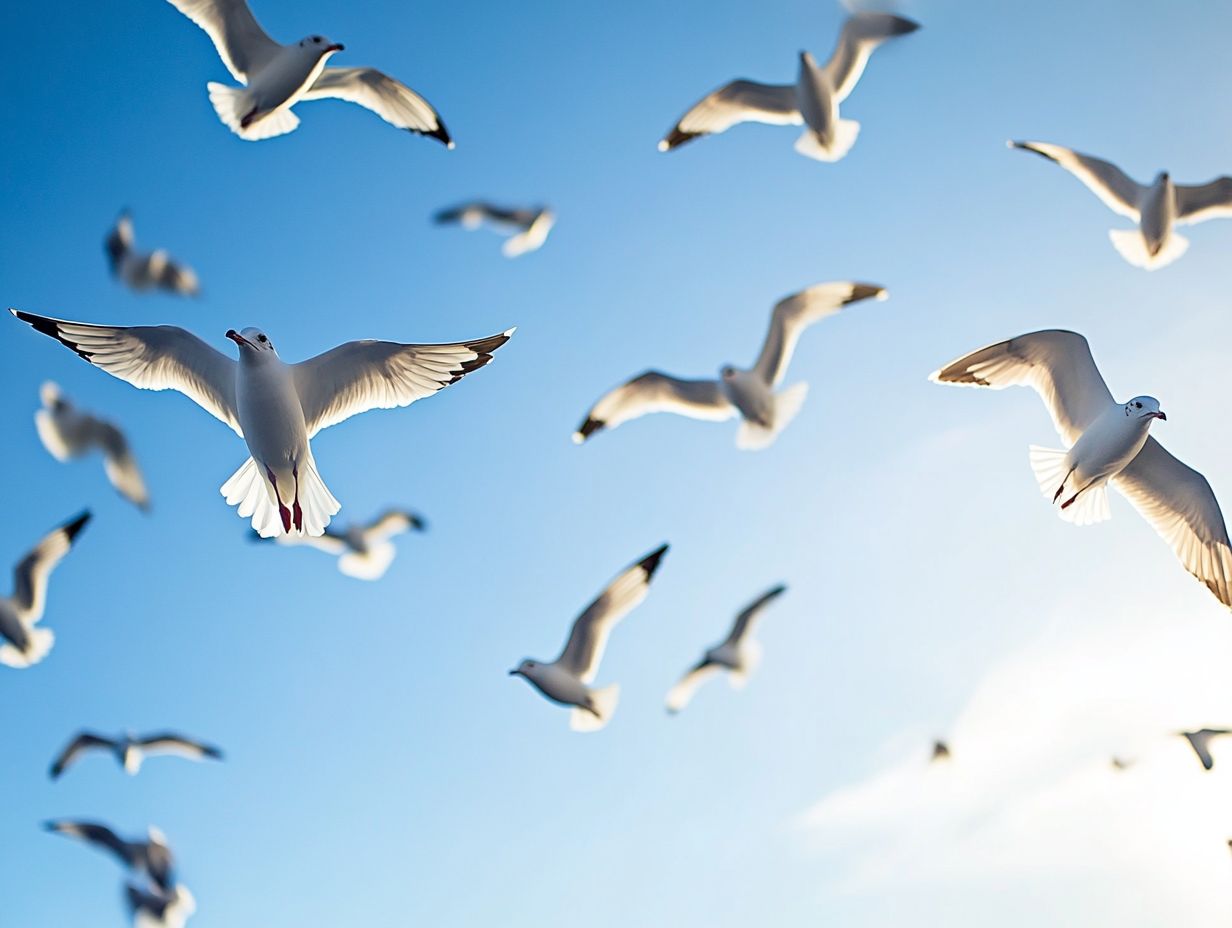
Flocking patterns differ significantly across species, revealing a fascinating array of formations and movements. You might observe the familiar V formation of migratory birds or be captivated by the intricate murmurations of starlings.
Each of these patterns underscores unique flocking dynamics that fulfill essential functions, such as conserving energy during lengthy flights and evading predators.
Next time you see birds flocking, take a moment to watch and appreciate this incredible natural phenomenon!
Formations and Movements
Flocking patterns showcase various formations and movements. Striking examples include the V formation in migratory birds, which saves energy while flying, and the captivating murmurations of starlings, illustrating how groups move together.
These formations have two main purposes: they optimize energy use, allowing birds to conserve their strength during long journeys, and they enhance strategies for evading predators. Flocks often shift shapes in response to environmental cues, as each bird reacts to its nearest neighbors. This creates a fluid dynamic that researchers study to gain insights into how groups of birds act together.
Thanks to cutting-edge high-speed cameras, we now see these birds’ amazing interactions like never before! They capture the intricate, rapid movements of birds, unveiling patterns that may appear chaotic yet are fundamentally rooted in physics. The fascinating interplay between individual agency and group cohesion reflects a profound principle of nature, inspiring both scientific inquiry and artistic creativity alike.
How Birds Communicate in Flocks
Birds employ a range of communication methods within their flocks, which are vital for sustaining flocking behavior and fostering interactions among neighboring individuals. This social behavior plays a key role in coordinating movements, adapting to environmental changes, and ensuring actions that significantly enhance overall safety and efficiency.
Methods of Communication
Various communication methods, including vocalizations and visual signals, are pivotal in the dynamics of social behavior within bird flocks. They facilitate interaction among neighbors and ensure cohesive movement.
Research has shown that certain species utilize distinctive calls to alert their companions to dangers, which is crucial for survival. For instance, studies on American chickadees have revealed specific alarm calls that indicate the type of predator approaching, allowing the flock to react appropriately.
Visual cues, such as wing flapping or body posture, reinforce social hierarchies within the flock, with dominant birds often displaying assertive movements to maintain their status. These communication strategies not only enhance the effectiveness of flocking behavior but also strengthen the bonds between individual birds, ultimately contributing to the overall stability of their social structure.
Factors Affecting Flocking Behavior
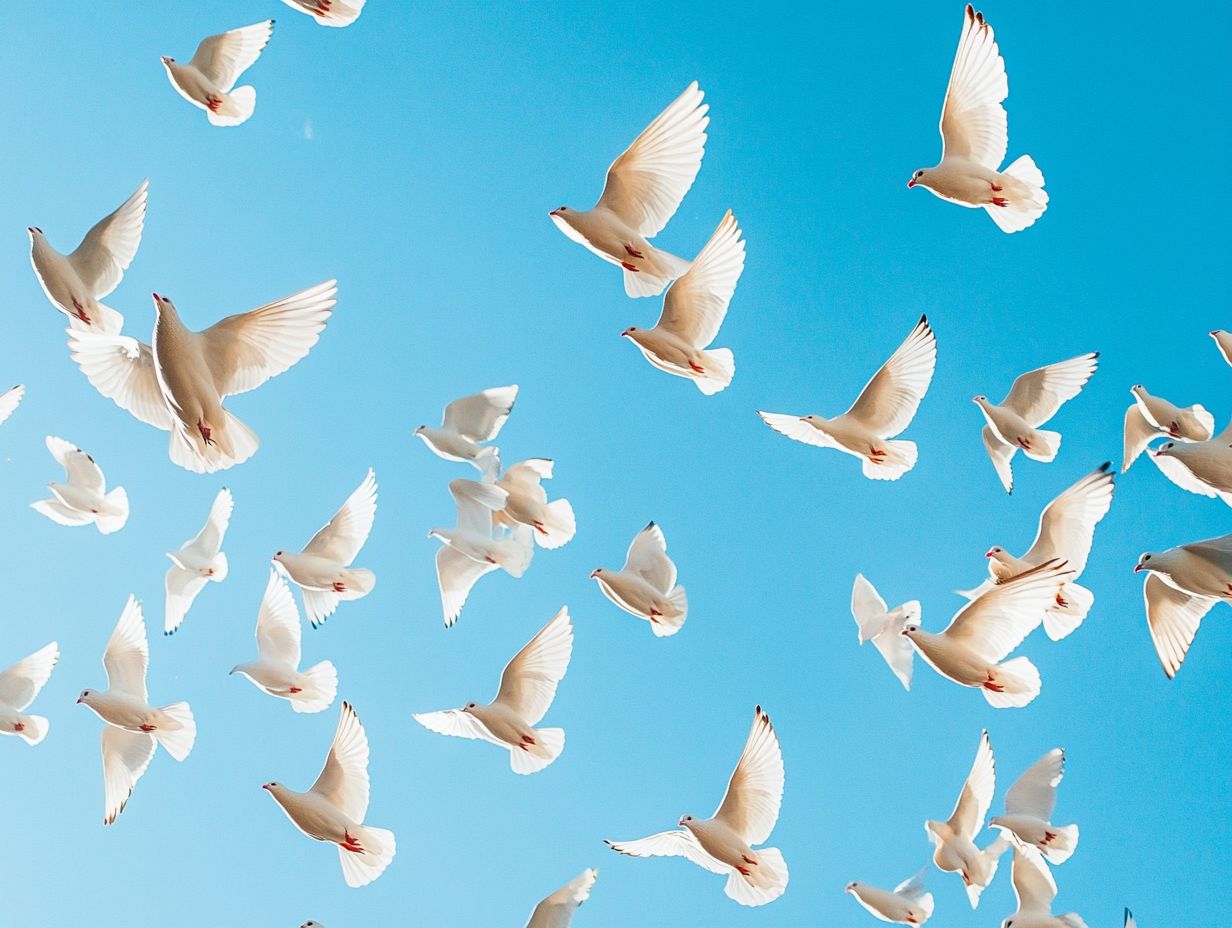
Flocking behavior is shaped by a myriad of factors, encompassing both elements of the environment and traits that govern how individuals engage within their flock. The size of the flock, coupled with the dynamics of interactions among neighbors, significantly influences the patterns of collective movement you observe.
Environmental and Species-Specific Factors
Environmental factors, like weather conditions and habitat, play a pivotal role in shaping flocking behavior. This is complemented by specific species elements, such as flock size and the dynamics of interactions among neighbors.
For example, birds often adjust their flocking patterns in response to shifts in temperature and precipitation. These changes can significantly impact food availability and the presence of predators. In colder climates, species like snow geese tend to gather in larger flocks, enhancing their protection against predators while conserving body heat through communal roosting.
Similarly, fish such as herring showcase schooling behavior that adapts based on light levels and water temperature, which influence their visibility to both prey and predators. These adaptations help each species survive better and find food more easily, vividly illustrating the intricate interplay between environmental factors and specific species influences on flocking strategies, including those observed in fish and insects.
Implications of Flocking Behavior
The implications of flocking behavior reach far beyond simple observations in nature; they play a crucial role in shaping conservation efforts and a variety of human activities.
By grasping the dynamics of flocking, you open new paths for innovative technologies and applications, particularly in fields like robotics and computer simulations.
This understanding can transform current practices and lead to exciting breakthroughs in future research in flocking studies, guiding you toward groundbreaking discoveries and advancements.
Impact on Conservation and Human Activities
Flocking behavior holds significant implications for conservation efforts and various human activities, which raises environmental awareness. By grasping these dynamics, you can play a crucial role in protecting endangered species and fostering environmental awareness.
When you analyze how birds and other animals navigate in groups, you unlock the ability to identify critical habitat areas that need protection ultimately enhancing species management strategies. For instance, studying migratory patterns has led to the establishment of protected zones that support avian populations during their long journeys.
The insights gained from flocking behavior have sparked innovative technologies, like drone swarms that mimic these natural systems for environmental monitoring and flocking technology. These advancements not only improve data collection for conservation but also shape policies prioritizing habitat preservation and sustainable practices related to collective motion and murmurations. This illustrates the intricate connection between nature and human initiatives, showing how your understanding of these dynamics can truly make a difference in flocking dynamics and animal behavior.
Frequently Asked Questions
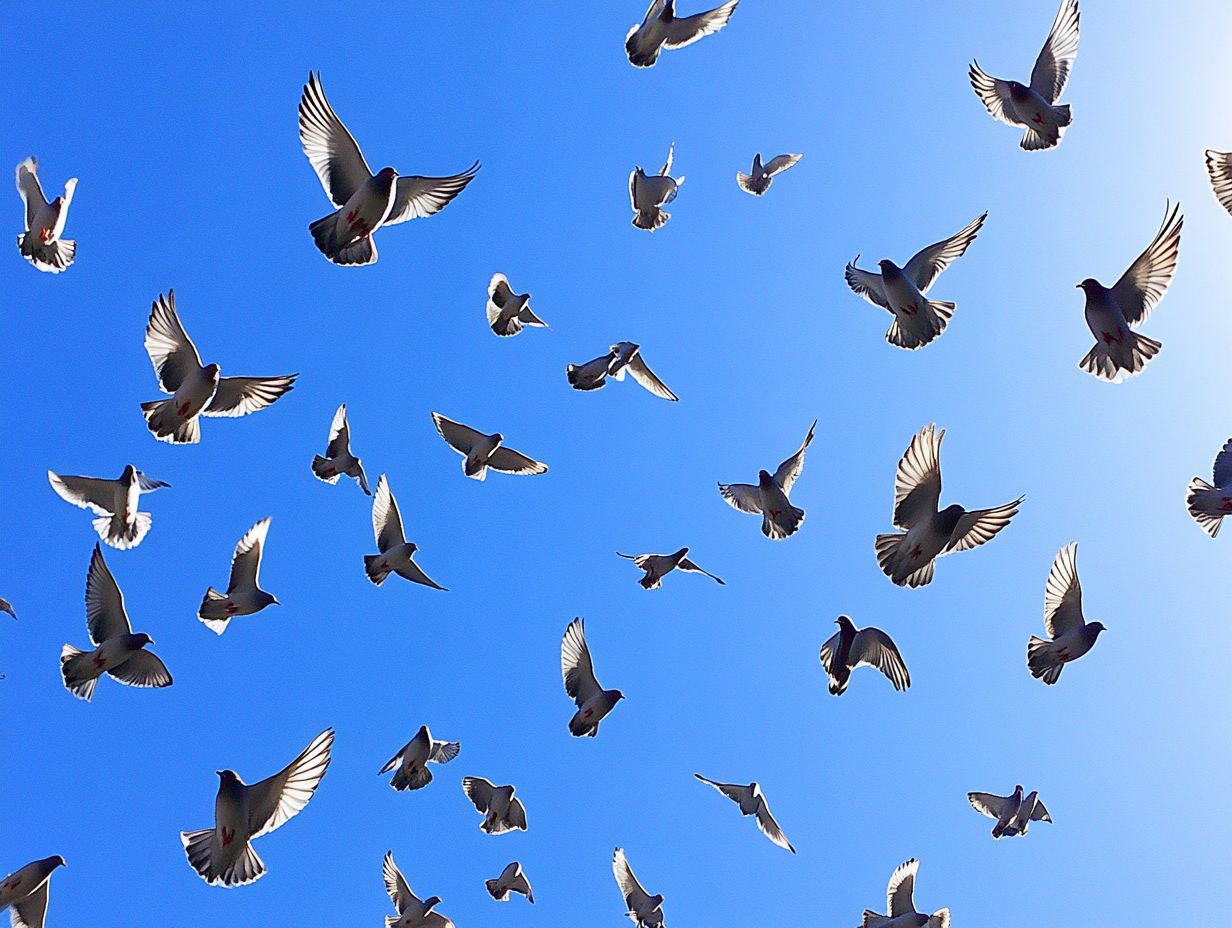
What is bird behavior?
Flocking behavior refers to the collective movement and behavior of a group of birds. It involves birds flying or moving together in a coordinated manner, often in large numbers.
Why do birds exhibit flocking behavior?
Birds exhibit flocking behavior for a variety of reasons, including predator avoidance, protection from predators, easier foraging and navigation, and social behavior.
How do birds coordinate their movements while flocking?
Birds use a variety of methods to coordinate their movements while flocking, such as visual cues, vocalizations, and following a leader, as well as high-speed cameras and steering behaviors (the ways birds adjust their flight based on others movements).
Do all bird species exhibit flocking behavior?
No, not all bird species exhibit flocking behavior. Some birds, such as birds of prey, are solitary and do not engage in flocking behavior.
What are the advantages of flocking behavior for birds?
Flocking advantages provide several benefits for birds, including increased protection from predators, improved foraging efficiency, and increased chances of finding a mate.
Is it possible for birds to change their flocking behavior?
Yes, birds can change their flocking behavior depending on the circumstances, such as during migration or group foraging. For example, they may flock more tightly together in response to a predator, or spread out when group foraging for food, thus demonstrating collective behavior.


